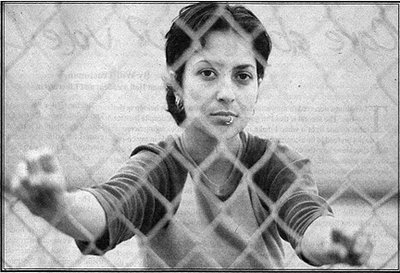
In honor of the fifth anniversary of "9-11," we offer the following.
It is an account of one young journalist's experiences in New York on that day, five years ago.
“GRAY”: New York, NY;
Sept. 11, 2001[from
Dissent 60, October 22, 2001]
SANAZ MOZAFARIAN[Remember Sanaz “Action Figure” Mozafarian? She was a terrific reporter for the IVC school paper (the Voice) some years ago. Since then, she’s gone off to college in Berkeley and New York and has done some reporting for The Nation. She’s presently working as a reporter at the Independent Media Center (IMC) in NY.
Sanaz was in the city on September 11th. Here’s her email account of that day, written early the following morning. –CW]

t’s three a.m., Wednesday morning, now officially the day after the World Trade Center terrorist attack. I’m sitting at the
Independent Media Center after an exhausting and chaotic day. I’m writing you all to let you know that I’m in one piece.…
I was in class when the planes exploded into the buildings, several miles north of downtown. As soon as I found out what had happened I began making my way there. Manhattan’s streets were chaotic. Smoke was billowing on the horizon, as people gathered around deli television sets.
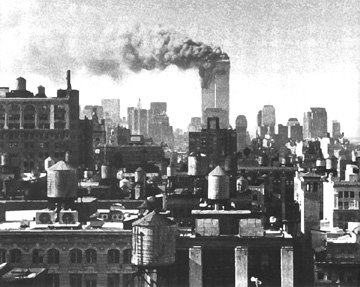
All the buses and subways were shut down and people were lined up for blocks to make phone calls. Eventually, a bus appeared that ran downtown. I climbed in the back and got down to Times Square and then frantically got out to watch Arafat on the big screen.
Hundreds of New Yorkers were gathered outside the CBS studios. People were crying and fixating on the screen for the next bit of information, cringing as the network replayed footage of the Twin Towers crumbling, glancing down the street to the hole in the sky where the buildings had been replaced by black smoke.
After the newscast became repetitive, I began walking downtown. After a brief stop at the IMC, on 29th street, I made it to a downtown bus on Fifth Avenue. No one knew where the bus would stop, not even the bus driver. Everyone was distracted by the beret-wearing National Guardsmen guiding traffic with rifles all along Fifth Avenue.
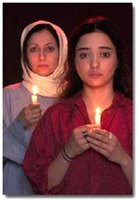
We were kicked off of the bus at 8th Street. From that point, until we made it to the foot of the towers, we were in the midst of total chaos. We sought to get to ground zero by any means possible, and the police were trying to keep us out of there by any means possible….
The situation reminded me a lot of trying to get into the “no protest zone” on December 1, 1999 in Seattle. At every street corner a different group of cops told us to take off in the opposite direction we wanted to go, and at every street corner we tried to convince them to let us in.
Eventually we made it to the foot of the Brooklyn Bridge where frantic volunteers in street clothing hauled two-by-fours and plywood to the park to make stretchers. These crude devices were then packed into empty garbage trucks and hauled along with volunteers to the foot of the buildings. The real urgency of the situation was not clear to me until I saw the hurried way these people worked and the number of stretchers they were making.
It was there that I met Paul and Jose. Paul, a 23 year-old white kid, came up to me and asked me for a cigarette. When I told him I didn’t have one, he began to talk, and I listened. He said that his father works in the North Tower, which tumbled first, on the 76th floor, and that he hadn’t heard from him since the buildings collapsed. His mission was to get into the building area and then to find his dad. Jose was his younger friend who presently looked like he was eighty years old. He walked with a limp, pulling his bike along with him. His hair was completely gray. He told me he was thrown several feet off his bike when the first plane hit. He was helping Paul.
I watched Paul almost get clubbed and arrested by a group of cops at a nearby barricade. I tried to calm him down. He was telling the cops that someone should have attacked their precincts. The coppers weren’t responding well to this.
As we got closer and closer to the foot of the buildings, the air got thicker, our skin and eyes dryer, our lungs weaker and our shoes and clothing grayer. The landscape of lower Manhattan was surreal, a thick gray dust covering everything. It reminded me of a post-bomb scene—or astronauts walking on the moon. The streets were deserted, except for a few business people and workers covered in dust with masks over their mouths and eyes, looking for a way out.

We were still a quarter mile from ground zero. The gray soot was mixed with hundreds of pages of charred paper, mostly financial reports and an occasional apple core and half-eaten bread. Venders had abandoned their fruit and bagel carts and people had looted them. Red and black smoke covered the skyline. Cars covered with dust had messages written on them: “You Can’t Stop NY”; “Revenge is the Only Answer.” We found a few water bottles, a couple of masks and marched on.
Repeatedly, we were turned back by cops. We lost track of where we were but kept moving; we tried every street. Soon we were walking down Wall Street toward Broadway. You could hardly see even one block.
Within minutes we heard a rumbling. The third building was falling: Seven World Trade Center, a forty-seven floor building near the towers. The dust and smoke that followed left us kneeling on the ground coughing and covering our eyes. We decided to take a different route.
Taking advantage of the dust and confusion, we were able to get close enough to see the once 110-floor building at a now-undaunting four-story height. Medics and volunteers, including many activists, were standing idly. The fire and excessive debris made it impossible for them to get to possible survivors. Ambulances couldn’t get in to pull people out.
We were quickly discovered and sent out of the area—itchy, exhausted, slightly blind and short of breath. We decided to get out before another building fell. Along the way, Paul, defeated, mumbled about the idiots who hijacked the planes. A few stragglers we had picked up, also young white boys, hoped that we’d go to war. I remained silent. What do you say to a kid who may have just lost his father so traumatically?
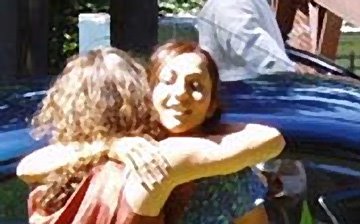
…[Later,] I gently tried to explain that people are killed like this…all the time, that the attack may have been a reaction to America’s international policies and actions. Being working class kids from Queens, Paul and Jose were not jumping to defend their government. Eventually we were agreeing, albeit not completely. Paul and Jose and I separated in Chinatown.…
I came back here to the IMC and we’re putting together some reports, shaking our heads in frustration as we watch Bush give his speech and Congress sing patriotic songs and reporters provide analyses about bin Laden. We are working hard, washing our clothes, skin and hair, trying to get the campfire smell out and trying not to scratch our skin too much. People pass out occasionally and then get up again to send emails and write stories and, every once in a while, we sit around together to figure out what we should do next.
The schools and most of downtown will be closed tomorrow, and so we’ll hold a meeting in Union Square at noon to discuss how to respond to the fervid patriotism emerging to fuel a possible war or bombing attacks. It feels like a daunting task…We have already heard that Arab NYC residents have been harassed in the streets and at their work places, but we haven’t heard about anything serious yet.
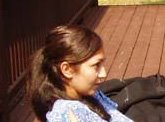
…Right now a few of us are going to ride down to the Javits Center where civilian volunteers are gathering for search and rescue teams. Needless to say, I’m not sure where I’ll be in a few hours from now. I’ll keep everyone updated…Do what you can locally. Any minute now we could be in the midst of massive war, internationally and nationally.
Good Luck
(See
Sanaz at The Nation: writing about IVC.)
(
Saddam had "no link to al-Qaeda". Surprise, surprise.)

 I have not always been a fan of the greenhouse. You may remember the firm public stand I took when a faculty member faced the loss of his job for allegedly placing a nameplate on the facility. I am a firm believer in rules, even those that don't exist at the time they are being enforced.
I have not always been a fan of the greenhouse. You may remember the firm public stand I took when a faculty member faced the loss of his job for allegedly placing a nameplate on the facility. I am a firm believer in rules, even those that don't exist at the time they are being enforced. 











